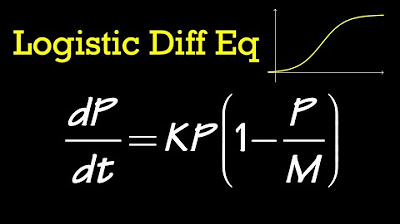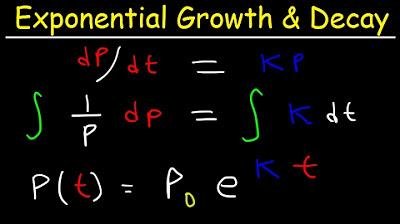Modeling population with simple differential equation | Khan Academy
TLDRThe video script delves into the application of differential equations for modeling population growth. It begins by defining variables for population (P) and time (t), with a focus on rapid-reproducing insects measured in days. The presenter suggests a model where the rate of population change is proportional to the current population size, a concept that may be familiar from algebra or precalculus. This leads to a separable differential equation, which the video encourages viewers to attempt solving. The solution process involves isolating variables and integrating, resulting in an exponential function that describes population growth over time. The general solution is expressed as P = C * e^(kt), where C is a constant and k is the proportionality constant. The video concludes by highlighting the relevance of this model to understanding population dynamics and sets the stage for future discussions on applying initial conditions to find specific solutions.
Takeaways
- 📐 **Modeling with Differential Equations**: The video begins by introducing the concept of using differential equations to model real-world phenomena, starting with population modeling.
- 🐞 **Variable Definition**: Defines P as the population and t as the time in days, which is relevant for modeling quickly reproducing organisms like insects.
- ✅ **Proportional Growth**: Suggests that the rate of population change is proportional to the current population size, which is a reasonable assumption for exponential growth.
- 🔄 **Differential Equation Logic**: Explains that the logic behind differential equations can be used to model growth, even if the idea might initially seem complex.
- 🧬 **Separable Differential Equation**: Identifies the differential equation as separable, which allows for the variables to be isolated and integrated.
- 📉 **Integration Process**: Demonstrates the process of integrating both sides of the equation after separating the variables, leading to a solution involving natural logs and exponentials.
- 🔗 **General Solution**: Arrives at a general solution for the population, which is an exponential function of time, a form that might be familiar from algebra or precalculus.
- 🌱 **Positive Population Assumption**: Assumes that the population is always positive, allowing for the removal of absolute value signs in the solution.
- 📈 **Exponential Function**: Highlights that the general solution is an exponential function, a common model for population growth in various contexts.
- ⏱️ **Time Dependency**: Emphasizes that the population growth is dependent on time, with the growth rate being proportional to the current population.
- 🔧 **Initial Conditions**: Mentions that in the next video, the process of applying initial conditions to find a particular solution to the differential equation will be covered.
- 📚 **Review and Application**: Suggests that the content is a review of algebra and precalculus concepts but applies them in the context of differential equations for modeling.
Q & A
What is the main topic of this video?
-The main topic of this video is exploring how to model things, specifically population, using differential equations.
What are the two variables defined in the video?
-The two variables defined are P, which represents the population, and t, which represents the time that has passed in days.
Why is the time span chosen as days for modeling the population of insects?
-Days are chosen as the time span because insects reproduce quite quickly, making it a relevant time frame to observe population changes.
What is a reasonable assumption for the rate of change of population with respect to time?
-A reasonable assumption is that the rate of change of the population with respect to time is proportional to the actual population.
Why is the rate of growth of the population considered to be proportional to the population itself?
-This is because the larger the population, the more individuals there are to reproduce, leading to a higher rate of growth at any given time.
What type of differential equation is used to model the population growth?
-A separable differential equation is used to model the population growth.
How does treating the differential as a fraction help in solving the equation?
-Treating the differential as a fraction allows for the separation of variables, which simplifies the integration process and helps in finding the solution to the differential equation.
What is the general form of the solution to the differential equation representing population growth?
-The general form of the solution is P = C * e^(kt), where P is the population, C is a constant, k is the proportionality constant, and t is time.
What is the significance of the exponential function in modeling population growth?
-The exponential function is significant because it represents a growth rate that increases over time, which is a common characteristic of population growth when resources are abundant.
What is the next step after finding the general solution?
-The next step is to apply initial conditions or known states of the population to solve for the constants and find a particular solution.
Why is it assumed that the population is positive in the solution?
-It is assumed that the population is positive because a negative population does not make sense in the context of modeling real-world scenarios.
What is the role of the proportionality constant (k) in the model?
-The proportionality constant (k) determines the rate at which the population grows or declines, based on the relationship between the population size and its growth rate.
Outlines
📚 Introduction to Modeling Population with Differential Equations
The video begins by introducing the concept of using differential equations to model real-world scenarios, specifically focusing on population growth. The presenter defines two variables: P for population and t for time, measured in days, which is suitable for rapidly reproducing organisms like insects. The core idea is that the rate of population change is proportional to the current population size, leading to a simple differential equation. The video then guides viewers through the process of solving this separable differential equation, emphasizing the approachability of the topic despite its complexity. The solution process involves separating variables, integrating, and applying initial conditions to find a particular solution. The presenter encourages viewers to pause and attempt the solution themselves, fostering active learning.
🧮 Solving the Differential Equation for Population Growth
Continuing from the introduction, the video script delves into solving the differential equation derived from the population growth model. The presenter demonstrates how to separate variables and integrate both sides to find the general solution. The solution process involves treating the derivative of P with respect to t as a fraction and integrating to obtain the natural logarithm of the population. The general solution is then expressed as a product of a constant times an exponential function of time, which is a common form in exponential growth models. The presenter highlights the familiarity of this form, likely encountered in algebra or precalculus, and connects it back to the differential equation's logic. The video concludes with a teaser for the next installment, where initial conditions will be applied to find a specific solution to the model.
Mindmap
Keywords
💡Differential Equations
💡Population Modeling
💡Variables
💡Rate of Change
💡Proportional
💡Separable Differential Equations
💡Integration
💡Natural Logarithm
💡Exponential Function
💡Initial Conditions
💡Constants
Highlights
The video explores how to model things with differential equations, starting with simpler models for population modeling.
Defines variables P for population and t for time in days, suitable for quickly reproducing insects.
Proposes a model where the rate of change of population with respect to time is proportional to the population itself.
Justifies the model by explaining that a larger population will have a higher reproduction rate.
Introduces the concept of using differential equations to express and solve problems related to population growth.
Demonstrates how to solve the differential equation by finding a general solution and then applying initial conditions.
Identifies the differential equation as separable, allowing for a clear separation of variables for integration.
Uses Leibniz notation to treat derivatives and differentials as fractions and quantities for the purpose of integration.
Integrates both sides of the equation to find the natural log of the population related to time.
Expresses the general solution as an exponential function of population, P = C * e^(kt), where C is a constant and k is the proportionality constant.
Assumes a positive population and removes the absolute value sign to simplify the general solution.
Relates the exponential function to previous knowledge from algebra or precalculus where similar functions were used to model population.
Highlights the underlying logic of the differential equation driving the model, based on the rate of change of population over time.
Plans to apply initial conditions in the next video to find a particular solution to the differential equation.
Encourages viewers to pause and attempt solving the differential equation on their own.
Explains the integration process of separable differential equations and how it applies to the population model.
Details the steps taken to isolate variables and perform the integration, leading to the general solution for population growth.
Discusses the practical applications of modeling population growth using differential equations and its relevance to real-world scenarios.
Transcripts
Browse More Related Video

The Logistic Equation and the Analytic Solution

Logistic Differential Equation (general solution)

Exponential Growth and Decay Calculus, Relative Growth Rate, Differential Equations, Word Problems

AP Calculus AB - 7.8 Exponential Models With Differential Equations

Solving the logistic differential equation part 1 | Khan Academy

Introduction to Time Rate of Change (Differential Equations 5)
5.0 / 5 (0 votes)
Thanks for rating: